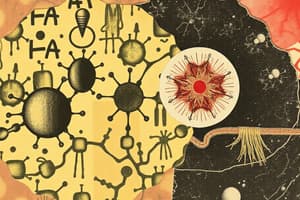Podcast
Questions and Answers
Which of the following is the MOST accurate definition of cell modification or differentiation?
Which of the following is the MOST accurate definition of cell modification or differentiation?
- A process where cells lose their original structure to become simpler.
- The process where cells become structurally modified to perform specific functions efficiently. (correct)
- A process where cells divide rapidly to increase tissue size.
- The process by which cells randomly change shape due to external stimuli.
Apical modifications are found exclusively on the basal surface of cells.
Apical modifications are found exclusively on the basal surface of cells.
False (B)
Name three examples of apical modifications found on epithelial cells.
Name three examples of apical modifications found on epithelial cells.
Cilia, Flagella, Microvilli
__________ are long, whip-like structures formed from microtubules that aid in cell movement.
__________ are long, whip-like structures formed from microtubules that aid in cell movement.
Match the cell modification type with its function.
Match the cell modification type with its function.
What is the primary function of villi found in the epithelial layer of some organs?
What is the primary function of villi found in the epithelial layer of some organs?
Desmosomes are primarily composed of keratin and function to link the cytoskeleton to the extracellular matrix.
Desmosomes are primarily composed of keratin and function to link the cytoskeleton to the extracellular matrix.
What is the role of tight junctions in epithelial layers?
What is the role of tight junctions in epithelial layers?
__________, also known as communicating junctions, allow direct exchange of chemicals between the cytoplasm of two adjacent cells.
__________, also known as communicating junctions, allow direct exchange of chemicals between the cytoplasm of two adjacent cells.
Which structure is NOT an example of an apical modification?
Which structure is NOT an example of an apical modification?
Flashcards
Cell Modification
Cell Modification
Process after cell division where newly formed cells are structurally modified to perform their function efficiently.
Apical Modification
Apical Modification
Located on the apical surface, includes cilia, flagella, villi, microvilli, pseudopods and extra cellular matrix.
Cilia
Cilia
Short, hair-like structures that move in waves.
Flagella
Flagella
Signup and view all the flashcards
Villi
Villi
Signup and view all the flashcards
Microvilli
Microvilli
Signup and view all the flashcards
Pseudopods
Pseudopods
Signup and view all the flashcards
Basal Modification
Basal Modification
Signup and view all the flashcards
Desmosomes/Hemidesmosomes
Desmosomes/Hemidesmosomes
Signup and view all the flashcards
Tight Junctions
Tight Junctions
Signup and view all the flashcards
Study Notes
- Cell modification/differentiation occurs after cell division and involves structural modifications to newly formed cells
- These modifications allow the cells to perform their functions efficiently and effectively.
- The three types of cell modification are Apical, Basal, and Lateral modifications.
Apical Modification
- Apical modifications are found on the apical surface of cells.
- This surface includes the basement membrane, gap junctions, adhering junctions, and tight junctions.
- The surface can be found on the free surface of epithelial tissue.
- Examples of apical modifications include cilia, flagella, villi, microvilli, pseudopods, and the extracellular matrix.
- Cilia are short, hair-like structures that move in waves.
- Flagella are long, whip-like structures formed from microtubules.
- Villi are finger-like projections that arise from the epithelial layer in some organs, increasing surface area for faster and more efficient absorption.
- Microvilli are smaller projections that arise from the cell's surface increasing surface area and allowing for more efficient absorption.
- Pseudopods are temporary, irregular lobes formed by amoebas and some other eukaryotic cells, they bulge outward to move the cell or engulf prey.
- The Extra Cellular Matrix (ECM)is a compound secreted by the cell on its apical surface.
- The cell wall is the extracellular structure in plant cells that distinguishes them from animal cells.
Basal Modification
- Basal modifications are found on the basal surface of cells.
- They sit on the basement membrane, gap junctions, adhering junctions, and tight junctions free surface of epithelial tissue.
- Desmosomes/Hemidesmosomes are anchoring junctions on the basal surface of the cell.
- They form rivet-like links between the cytoskeleton and extracellular matrix components such as the basal lamina.
- Desmosomes are primarily composed of keratin, integrins, and cadherins.
Lateral Modification
- Lateral modifications are found on the lateral surface of cells.
- Tight junctions act as barriers regulating the movement of water and solutes between epithelial layers.
- Adhering junctions are anchoring junctions on the lateral surface of the cell.
- They fasten cells to each other's basement membrane.
- Gap junctions, also known as communicating junctions, are closable channels that connect the cytoplasm of adjoining cells.
- The presence of connexons allows for the direct exchange of chemicals between the cytoplasm of two cells.
Studying That Suits You
Use AI to generate personalized quizzes and flashcards to suit your learning preferences.




